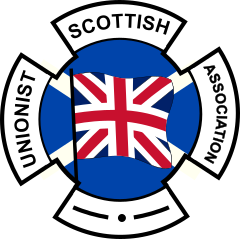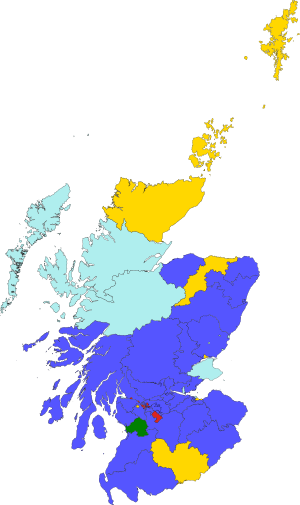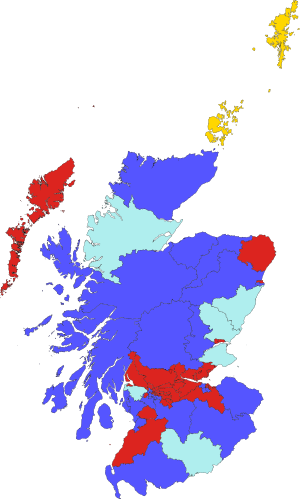Unionist Party (Scotland) facts for kids
Quick facts for kids
Unionist Party
|
|
|---|---|
 |
|
| Founded | 1912 |
| Dissolved | 1965 |
| Preceded by |
|
| Merged into | Scottish Conservatives |
| Ideology |
|
| Political position | Centre-right |
| National affiliation | Conservative Party |
The Unionist Party was a major political party in Scotland. It was active from 1912 until 1965. This party was generally seen as "centre-right," meaning its ideas were a mix of traditional and modern views.
Even though it was a Scottish party, it worked closely with the Conservative Party in England and Wales. Unionist Members of Parliament (MPs) in London often voted with the Conservatives. Famous leaders like Bonar Law and Sir Alec Douglas-Home, who both became Prime Minister, were from the Scottish Unionist Party.
The Unionist Party usually didn't run in local elections. Instead, it supported the Progressive Party against the Labour Party. This changed later when the Conservatives started running their own candidates.
Contents
How the Unionist Party Started
The Unionist Party began after a big change in the Liberal Party in 1886. This led to the creation of the Liberal Unionists. The "Union" they cared about was the one between Great Britain and Ireland, not the older union between Scotland and England.
Before this, the Conservative Party in Scotland was not as strong as the Liberals. But the Liberal Unionists and Conservatives worked together. This helped them become much stronger in Scottish elections.
In 1912, the Liberal Unionists and Conservatives officially joined to form the Conservative and Unionist Party. In Scotland, the Scottish Unionist Party acted like the Conservative Party. However, some candidates still used the "Liberal Unionist" name because the word "Liberal" was popular in Scotland.
What the Party Believed In
A main idea for the Scottish Unionist Party was to keep the British Empire strong and united. Even though they worked with the UK Conservative Party, they wanted to show they were a Scottish party. They avoided using the word "Conservative" until 1965. For example, they would change "Conservative" to "Unionist" in their leaflets.
The party gained a lot of support from working-class people. They said that staying united with the Empire helped Scottish industries. They also believed in unity across different social classes. The party also had strong links to Protestantism, which helped them gain support in some areas. They supported well-known members of the Church of Scotland and leaders from the Grand Orange Lodge of Scotland.
Being an independent Scottish party also helped them. They presented themselves as a Scottish choice against the Labour Party, which they said was too focused on London. They called Labour "Socialist" to make it seem less Scottish. This was especially true in the 1940s and 1950s. They also opposed Labour's plans to take control of Scottish businesses and services.
The party tried to appeal to different voters. They talked about both individual freedom and helping the community. This made them seem flexible and practical.
Election Success and the 1955 Election
As the Liberal Party became weaker, the Scottish Unionist Party attracted many former Liberal voters. The creation of the National Liberals also helped the Unionist vote grow.
The Labour Party became a threat to the middle classes. In 1924, the Scottish Unionists won most of Scotland's seats in the general election. They won 37 out of 73 seats. After a small dip in 1929, they did very well in the 1931 election. This was when the National Government was formed. The Scottish Unionist Party won 58 out of 73 Scottish seats, which was 79% of them. In 1935, they won 45 MPs.
However, in the 1945 election, Labour won by a lot. The Unionists only won 30 of Scotland's 71 seats. In 1950, Labour won more MPs again, but the Unionists got closer with 32 MPs. In 1951, the number of Labour and Unionist MPs from Scotland was equal, with 35 each.
The 1955 general election was a huge success for the Unionist Party. They won 50.1% of the vote and 36 out of 71 seats in Scotland. This is often seen as their best result ever. Six of these MPs were elected as Liberal Unionists or National Liberals. However, this success was followed by events that weakened the party.
Joining the Conservative Party
After losing six seats in the 1964 United Kingdom general election, the Scottish Unionist Party changed in 1965. It was renamed the "Scottish Conservative and Unionist Party." This meant it was no longer an independent party. It came under the control of the main UK Conservative Party. More changes in 1977 made the Scottish Conservatives a regional part of the UK party. Their staff, money, and offices were controlled by the party leaders in London.
What Happened After the Merger
As the British Empire ended, the strong links to Protestant groups also faded. More people became less religious. This meant the Unionist Party lost many of its working-class Protestant supporters. Even though many Conservatives still went to the Church of Scotland, most church members did not see themselves as Conservatives.
The Daily Record newspaper, which used to support the Unionists, switched to supporting Labour. In the 1960s, the Conservative Party was often shown as a party for rich, English-style aristocrats. This, along with the new name, made many former Unionist voters switch to the Labour Party or the Scottish National Party (SNP). The SNP gained a lot of support in the 1974 elections.
The relationship between the Scottish Conservatives and the Orange Order also became difficult. This was partly because of the new image of the Conservatives. But the biggest problem was The Troubles in Northern Ireland. People started to link the Orange Order with violence, even though the Scottish Orange Order was stricter about members involved in violence. The Scottish Conservative Party tried to distance itself from these past links. Any remaining connections were broken when Prime Minister Margaret Thatcher signed the Anglo-Irish Agreement. This led some Orange Lodges to form their own Scottish Unionist Party in 1986.
Election Results
This table shows how the Scottish Unionist Party performed in general elections. It lists the percentage of votes and the number of seats they won in Scotland.
| Election | Vote % | Seats | Outcome of election |
|---|---|---|---|
| 1918 | 30.8% |
28 / 73
|
'Coalition' Conservative Hung Parliament / 'Coalition' Liberal Victory |
| 1922 | 25.1% |
13 / 73
|
Conservative Victory (Unionist Prime Minister) |
| 1923 | 31.6% |
14 / 73
|
Conservative Hung Parliament |
| 1924 | 40.7% |
36 / 73
|
Conservative Victory |
| 1929 | 35.9% |
20 / 73
|
Labour Hung Parliament |
| 1931 | 49.5% |
48 / 73
|
Conservative Victory |
| 1935 | 42.0% |
35 / 73
|
National Government (Conservative) Victory |
| 1945 | 36.7% |
24 / 71
|
Labour Victory |
| 1950 | 37.2% |
26 / 71
|
Labour Victory |
| 1951 | 39.9% |
29 / 71
|
Conservative Victory |
| 1955 | 41.5% |
30 / 71
|
Conservative Victory (Unionists & National Liberal total was 50.1% of the vote and 36 seats) |
| 1959 | 39.8% |
25 / 71
|
Conservative Victory |
| 1964 | 37.3% |
24 / 71
|
Labour Victory (Incumbent Unionist Prime Minister) |
Party Chairmen
- George Younger, 1916–1923
- The Marquess of Linlithgow, 1924–1926
- Harriet Findlay, 1928
- John Craik-Henderson
- Viscount Stuart of Findhorn, 1950–1962
- Michael Noble, 1962–1963
- Sir John George, 1963–1965
- John Gilmour, 1965–1967



